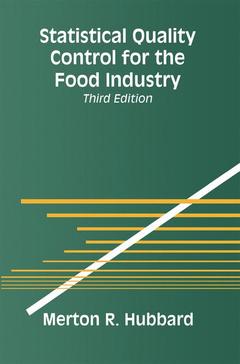Description
Statistical Quality Control for the Food Industry (3rd Ed., 3rd ed. 2003. Softcover reprint of the original 3rd ed. 2003)
Author: Hubbard Merton R.
Language: English
Subject for Statistical Quality Control for the Food Industry:
Statistical Quality Control for the Food Industry (3rd Ed.)
Publication date: 09-2012
343 p. · 15.5x23.5 cm · Paperback
Publication date: 09-2012
343 p. · 15.5x23.5 cm · Paperback
Approximative price 131.82 €
Subject to availability at the publisher.
Add to cart
Statistical quality control for the food industry (3rd ed )
Publication date: 06-2003
346 p. · 22.9x15.2 cm · Hardback
Publication date: 06-2003
346 p. · 22.9x15.2 cm · Hardback
Description
/li>Contents
/li>Comment
/li>
Specifically targeted at the food industry, this state-of-the-art text/reference combines all the principal methods of statistical quality and process control into a single, up-to-date volume. In an easily understood and highly readable style, the author clearly explains underlying concepts and uses real world examples to illustrate statistical techniques.
This Third Edition maintains the strengths of the first and second editions while adding new information on Total Quality Management, Computer Integrated Management, ISO 9001-2002, and The Malcolm Baldrige Quality Award. There are updates on FDA Regulations and Net Weight control limits, as well as additional HACCP applications. A new chapter has been added to explain concepts and implementation of the six-sigma quality control system.
This Third Edition maintains the strengths of the first and second editions while adding new information on Total Quality Management, Computer Integrated Management, ISO 9001-2002, and The Malcolm Baldrige Quality Award. There are updates on FDA Regulations and Net Weight control limits, as well as additional HACCP applications. A new chapter has been added to explain concepts and implementation of the six-sigma quality control system.
1 Introduction.- Variability.- Quality Control Programs.- Problems with Tool Selection.- Quality Control Tools.- 2 Food Quality System.- The Formalized Quality System.- Quality System Guidelines.- Malcolm Baldridge National Quality Award.- Total Quality Management.- Team Quality Systems.- Computer Network Quality Systems.- Summary.- 3 Control Charts.- The Importance of Charting.- Procedure for Constructing X-Bar and R Charts.- Procedures for Constructing Attribute Charts.- 4 Fundamentals.- Analysis of Data.- Probability.- Binomial Distribution.- The Normal Distribution.- Distribution of Sample Means.- Normal Approximation to the Binomial Distribution.- t-Distribution.- Confidence Limits for the Population Mean.- Statistical Hypotheses—Testing Hypotheses.- Distribution of the Difference Between Means.- Paired Observations.- F-Distribution.- Analysis of Variance.- Two Criteria of Classification.- 5 Sampling.- Sampling Plans.- Why Sample?.- Samples from Different Distributions.- Sample Size.- How to Take Samples.- Types of Samples.- Sampling Plans.- Types of Inspection.- Classes of Defects.- Sampling Risks.- Selection of Population to be Sampled.- Selection of Sample Frequency and Location.- Hazard Analysis Critical Control Point.- Attribute Sampling Plans.- 6 Test Methods.- General Analysis.- Special Instrumentation.- Microbiology.- Sensory.- 7 Product Specifications.- 8 Product Capability.- Capability Index.- Benchmarking.- 9 Process Control.- Chart Patterns.- Using the Control Chart as a Quality Management Tool.- 10 Sensory Testing.- The Senses.- Sensory Testing Methods.- Types of Panels.- Selection and Training.- 11 Net Content Control.- Evaluation of Net Content Performance.- Interpreting Net Content Control.- Procedures for Setting Fill Targets.- 12 Design of Experiments.- Elimination of Extraneous Variables.- Handling many Factors Simultaneously.- Full Factorial Designs.- Fractional Factorial Designs.- Response Surface Designs.- Mixture Designs.- Experimental Design Analysis by Control Chart.- 13 Vendor Quality Assurance.- Vendor-Vendee Relations.- Specifications for Raw Materials, Ingredients, Supplies.- Quality Assurance of Purchased Goods.- Selecting and Nurturing a Supplier.- Packaging Supplier Quality Assurance.- Supplier Certification Programs.- 14 Implementing a Quality Control Program.- Management Commitment.- Getting Started.- An In-House Program.- Team Quality Systems.- Stepwise Procedures for Team Problem Solving.- Programs without Management Support.- Training Quality Control Technicians.- Summary.- 15 The Computer and Process Control.- Computer Integrated Management.- Artificial Intelligence and Expert Systems.- Computer-controlled Processing.- Summary.- 16 Six-Sigma.- Summary.- References.
Maintains the strengths of the first and second editions while adding new information on Total Quality Management, Computer Integrated Management, ISO 9001-2002, and
The Malcolm Baldrige Quality Award
© 2024 LAVOISIER S.A.S.

